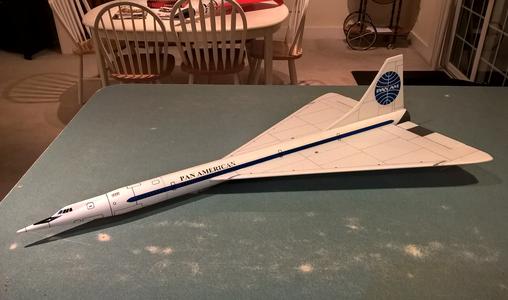

down elevator

Left aileron
glue in the control horn with the pushrod closest to the body tube, repeat on other side, then flip over model and put some CA on the post that sticks through the top of the control surface.
Welcome to the world of rocket boosted radio control gliders. This is not a model for a novice RC pilot, but anyone who is comfortable with RC flying of a medium speed model should be fine. Read through the instructions, look at the photos and be sure you understand the step before commiting to cutting or glue.
StratoDart Rocket glider instructions
Identify all pieces, the kit should contain:
1 wing taped together
1 wing spar(carbon fiber)
1 Nose Cone
2 pushrods
1 vertical stabilizer
2 control horns
2 Centering rings
2 Body Tubes
Motor mount
Velcro(for battery and rx/bec attachment)
2 Rail buttons with t nuts/screws or 1 Launch lug
2 landing skids
3M blenderm tape
Lead weight
Spare depron
Notes before starting:
Reference to CA+ means foam safe CA+, normal CA+ will melt the foam! Normally you need to use accelerator to get the CA to set on the foam since there is nothing for it to soak into and activate.
You may use 220-320 grit sandpaper and a sanding block to slightly round the edges of the foam if you prefer that look. It will not markedly impact the flight performance either way. Be very careful and use a light touch, it is very easy to catch the foam on the edge of the paper and tear the foam. Do any sanding before assembly.
Epoxy is not needed in this model. Weight is critical and the model is designed for the thrust and flight loads. Weight in the rear end is bad and will require additional weight in the front of the model.
Assembly:
- Unfold the wing and glue the pre-taped joint using CA+ and accelerator, make sure it is flat
- Glue the wing spar in the pre-slotted area on the bottom of the wing with CA+ and then tape over with the included blenderm tape.
- Glue the two centering rings on the motor mount. The mount is marked for the two rings, and the rings have a notch cut to clear the motor hook. Note the front of the motor mount has the ring closest to the end.
- Body Tubes. One tube will have a coupler glued in place. Glue the other tube onto the coupler, make sure the small arrow marks are aligned on the two tubes, that will ensure the wing slot mark and rail button marks are properly aligned. Use CA+ sparingly, as you will need to cut through the coupler to cut the wing slot.
- Cut the slot for the wing. I used a piece of angle aluminum to do this as it won't slip while I'm cutting. Take your time and be careful. Test fit the wing in the slot, if it is snug, sand or trim as you don't want it to drag/damage the wing as you are inserting it.
- Make a hole in the rear and front rail button locations marked on the bottom of the tubes to fit the t nuts. Insert the T nuts from the inside of the tube and install the T nuts, rail buttons and screws, don't tighten them down really hard, just snug enough to not come out. Make sure they are aligned and don't bind on the rail.
- Insert the wing and make sure it is centered, then glue in place with foam safe CA+
- Glue the motor mount into the rear of the model, the motor mount will butt against the wing inside the tube. You don't need a lot of glue here, just enough to keep it from falling out, the wing will keep it from moving forward.
- Test fit the vertical tail into the slot and make sure it fits. Make sure the tail is straight with no warps, bend carefully by hand to straighten it if needed. Glue into the slot using foam safe CA+ making sure the tail is perpendicular to the wing and is straight.
- Insert a pushrod into the outermost hole in each control horn. Make sure you insert from the left side on one, and from the right side on the other. Glue each control horn in place on the bottom of the surface, the holes should be pointing toward the front of the model and the pushrod should be closest to the body tube. Repeat on the other side.
- Put some CA on the top of the control surface where the horn prongs stick through, this locks it in place.
- Install a landing skid just ahead of each rail button. Use a drill or tool to make starter holes for the prongs. Make sure they are aligned with the buttons and don't drag on the rail, these help prevent button damage when landing. Use CA+ to hold them in place. Make sure the forward rail button prongs don't interfere with the nose cone shoulder.
The basic construction is now complete.
Radio Installation
Note: Your radio needs to be configured for Delta mixing, this means that the servo arms will move the same direction during elevator stick movement and opposite for aileron stick movement. Connect your servos to the receiver one in the aileron connection and one on the elevator connection and apply power. Use a servo arm at least 9/16” long and with holes small enough that there won’t be slop with the pushrod wire when installed. I use the hole furthest out on the servo arm, to maximize movement. On some servos there are a long two-ended servo arm, you can trim off one end if needed to get sufficient length. Zero out any trim settings on the transmitter. The model once the motor has burned out is nose heavy and flying wings lose pitch authority when nose heavy so you want as much up elevator travel for trim/flare as possible.
- Connect a servo to each pushrod. If the pushrod is too tight, you can use twist an exacto knife in the servo arm hole to make it larger, but be careful and do not make it too large. The servo electrical wires should be pointed toward the front of the model and the servos should be right next to the body tube. Once connected, tape each servo in place so that the control surfaces are centered. Flip the model right side up and look at it from the rear. Moving the transmitter stick back(up elevator) should move both elevons up. Moving the transmitter stick to the right should move the right elevon up and the left elevon down. If you can’t get the servo reversing to give you the right polarity try swapping aileron/elevator inputs to the receiver or turning the servos over and swapping the servo arms to the other side of the output shaft. If that is correct, continue.
- Flip the model upside down and supported. The servos may be attached to the model using double back servo mounting tape(not included) or by directly gluing the servo to the wing with CA+ or a small amount of epoxy. Double back servo tape can loosen over time and with exposure to heat, I prefer to glue the servo in place. With the radio still on, put a small amount of glue on the servo, being careful not to get any near the output shaft. And set it in place on the model keeping the control surface centered. Do the same to the other side. Make sure the glue is set before continuing. The servo and pushrod should be at 90 degrees to the hinge line so that it moves easily and fully.
- Flip the model back right side up. Make sure the control surfaces are centered, use trims if needed. Now measure the control surface movement. Full elevator movement should be 1” in each direction, aileron movement should be 1/2" in either direction. Since the model will be nose heavy, extra elevon movement helps to give sufficient authority during glide.
- If you have a flap/elevator mix you can program up elevator to a switch setting. The model needs approximately 1/4” of up elevon during glide. If you can’t set the up elevator trim to a switch on your radio you’ll have to manually put in boost and glide trim which is hard to do while flying the model.
- Attach a 16-18" servo extension to each servo.You just need to be able to route the wire to the front of the tube to attach it to the receiver.
- Make a 1/8" wide by 1/2" long slot in the bottom of the wing/fuselage on each side and pass the wires through to the inside and toward the front. On my model I just made a U shaped cut, folded the cardboard forward, inserted the wire then folded the cardboard back over the slot/wire. I then taped over that with blenderm tape to avoid having a large open slot. See photo for more clarity. You can also just cut the slot out completely and cover it over with tape after inserting the wire.
- Attach the servo wires to the receiver and make sure they are going the right direction. Tape down the servo wires to the wing and tape over the slot in the body tube.
- Use the included Velcro to attach the receiver 2" from the front of the body tube at the top(or enough to allow the wires to clear the shoulder of the nose cone). This allows you to be able to remove and replace the receiver if needed for repairs or for removing the servo wires. I attached the battery inside nose cone on the shoulder.
- Insert your heaviest loaded rocket motor into the motor mount
- Support the model at the balance point indicated for boost. I use two pencils with the eraser pointed up and held in place with a small hand vice. Place the model upside down on the pencil erasers on the balance point indicated in the kit spec sheet. Use the included lead weight to balance it by placing it as far forward in the nose or at the tail of the model as needed. Do not try to fly the model with it balancing it behind this point. The adage is, a nose heavy model flies poorly, a tail heavy model flies once
- If you use self adhesive vinyl from stickershock23, it helps once applied to use a hair dryer on hot to soften the material and then push it down onto the model with a towel. It helps it confirm and stick much better.
- Use a black sharpie to add panel lines if desired
- Re-install the receiver and battery
Flying: See the Instruction/Information link at the top for flying instructions. Be ready on the first few flights to keep the model straight till you have the trims set perfectly for boost and glide.
cut a small slot in the body tube and route the servo wire and extension forward to the front of the model, fold the tab back and glue in place to hide the hole.
Up Elevator
StratoDart Rocket Glider Kit
The StratoDart RC Rocket glider kit. It features a mid mounted sst/concorde style delta wing and tail, a plastic nose cone with molded panel lines, 2" white tubing for the body and depron wing and tail surfaces. It has a light wing loading giving it a very nice glide and easy/stable boost. Construction is very simple and takes about an hour and a half. The only hard part on this model is cutting the slot for the wing after you assemble the body tubes, however the slot locations are pre-marked for you. You will need two 10 gram type servos, two 12"-18" servo extensions, a receiver, and a small 500mah single cell lipo battery. You will need a transmitter with delta or elevon mixing. Stickershock has cut vinyl decal sets for both Pan Am and TWA logos that will fit this model. Click here:
Please refer to the notes on items needed for completion and flying, then read the instructions completely before starting assembly. The assembly photos are for general reference but may not include every step in the instructions. If you want hardcopy to work from, all you have to do is click/drag/select and copy all of the text below the photos, open word and paste with "keep original format" and it looks exactly like it does online then you can print it.
CG location for rocket flight: 13" measured from the rear end of the main body tube assembly, this should be approx 1/2" behind the joint between the two body tubes.
Up trim for glide
Carefully cut the wing slots, check that the wing fits easily in the slot. Take your time and use a sharp exacto and angle aluminum guide if possible.
Right aileron

Insert a pushrod into the outermost hole in each control horn, make sure you insert a rod into a right and left side control horn.


Glue the centering rings on the motor mount at the pre-marked lines.

Install a servo on the inside of each pushrod then glue in place once control directions are correct and the surfaces are centered.
Radio Controlled Rocket Glider Kits
connect the servo wires to the receiver, make sure the controls are moving the correct way, then velcro the receiver to the inside top of the body tube about 2" back from the end.
Install the rail button assembly onto the blind nut. Repeat for the front rail button.
Red vinyl stripe on bottom to help with orientation.
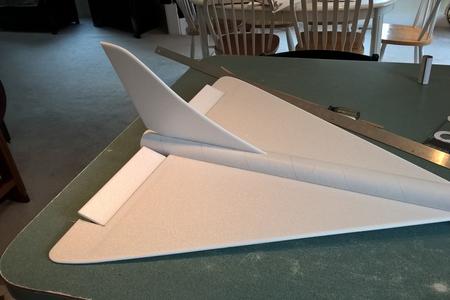




Using a tool make a hole in the front and rear RB marks to fit the rail button blind nut.

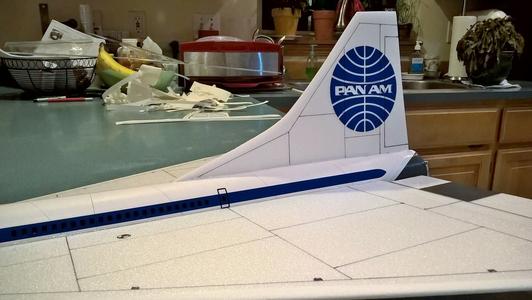

Glue the wing joint using foam safe CA+
Completed Airframe.

Insert the wing into the slot.

Glue in the rear skid in front of the rail button. Use an exacto then a round screwdriver to make the holes for the posts.


Add a small amount of CA+ to the top of the control horn posts to lock them in place.


Make sure the wing is centered and glue in place with foam safe CA+

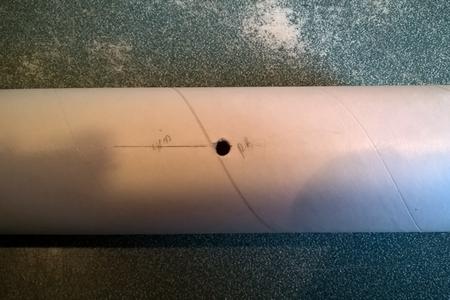

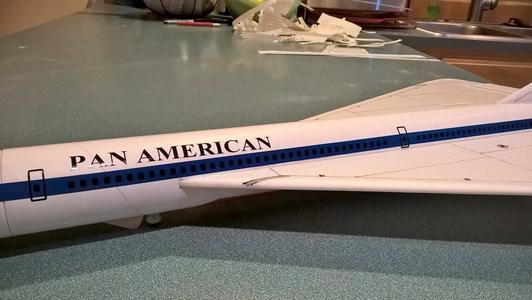


Glue the body tubes together using CA+ making sure to align the "coupler" marks
install the battery
Glue the vertical tail into the slot, make sure it is perpendicular to the wing and the tail is straight with no warps.

Downtrim for boost

Install the motor mount in the rear of the model and glue with CA+

insert the rail button blind nuts
Glue the front skid in front of the rail button, make sure the skid does not interfer with the nose cone shoulder.
Kit Contents


Stickershock Markings



Glue in the spar, then tape over with blenderm tape
Put a small piece of velcro in the inside shoulder of the nose cone for the battery.

